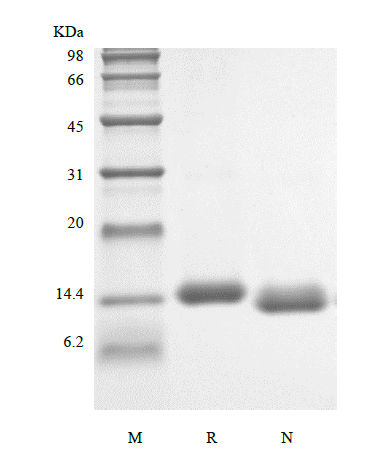- Synonyms
- Granulocyte/Macrophage Colony-Stimulating Factor, CSF-2, MGI-1GM, Pluripoietin-α
- Source
- Escherichia coli.
- Molecular Weight
- Approximately 14.5 kDa, a single non-glycosylated polypeptide chain containing 127 amino acids.
- AA Sequence
- APARSPSPST QPWEHVNAIQ EARRLLNLSR DTAAEMNETV EVISEMFDLQ EPTCLQTRLE LYKQGLRGSL TKLKGPLTMM ASHYKQHCPP TPETSCATQI ITFESFKENL KDFLLVIPFD CWEPVQE
- Purity
- > 98 % by SDS-PAGE and HPLC analyses.
- Biological Activity
- Fully biologically active when compared to standard. The ED50 as determined by a cell proliferation assay using human TF-1 cells is less than 0.1 ng/ml, corresponding to a specific activity of > 1.0 × 107 IU/mg.
- Physical Appearance
- Sterile Filtered White lyophilized (freeze-dried) powder.
- Formulation
- Lyophilized from a 0.2 μm filtered concentrated solution in PBS, pH 7.4.
- Endotoxin
- Less than 1.0 EU/μg of rHuGM-CSF as determined by LAL method.
- Reconstitution
- We recommend that this vial be briefly centrifuged prior to opening to bring the contents to the bottom. Reconstitute in sterile distilled water or aqueous buffer containing 0.1 % BSA to a concentration of 0.1-1.0 mg/mL. Stock solutions should be apportioned into working aliquots and stored at ≤ -20 °C. Further dilutions should be made in appropriate buffered solutions.
- Stability & Storage
- Use a manual defrost freezer and avoid repeated freeze-thaw cycles.
- 12 months from date of receipt, -20 to -70 °C as supplied.
- 1 month, 2 to 8 °C under sterile conditions after reconstitution.
- 3 months, -20 to -70 °C under sterile conditions after reconstitution.
- Usage
- This material is offered by Shanghai PrimeGene Bio-Tech for research, laboratory or further evaluation purposes. NOT FOR HUMAN USE.
- SDS-PAGE

- Reference
- 1. Wang JM, Chen ZG, Colotta F, et al. 1988. Behring Inst Mitt: 270-3.
2. 1989. N Engl J Med, 320: 253-4.
3. Nissen-Druey C. 1989. Nouv Rev Fr Hematol, 31: 99-101.
4. Eager RandNemunaitis J. 2005. Mol Ther, 12: 18-27.
5. Tran T, Fernandes DJ, Schuliga M, et al. 2005. Br J Pharmacol, 145: 123-31.
- Background
- Granulocyte-Macrophage Colony Stimulating Factor (GM-CSF) is secreted by a number of different cell types (including activated T cells, B cells, macrophages, mast cells, endothelial cells and fibroblasts) in response to cytokine or immune and inflammatory stimulation. It was initially characterized as a growth factor that can support the in vitro colony formation of granulocyte-macrophage progenitors and has functions of stimulates the growth and differentiation of hematopoietic precursor cells from various lineages. GM-CSF has also been reported to have a functional role on non-hematopoietic cells and can induce human endothelial cells to migrate and proliferate. Additionally, it can stimulate the proliferation of a number of tumor cell lines, including osteogenic sarcoma, carcinoma and adenocarcinoma cell lines. Human GM-CSF shares 54 % sequences identity with mouse GM-CSF, but has no biological effects across species. GM-CSF is used as a medication to stimulate the production of white blood cells following chemotherapy and has also recently been evaluated in clinical trials for its potential as a vaccine adjuvant in HIV-infected patients.







 COA申请
COA申请
